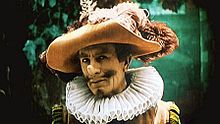| This article needs additional citations for verification. Please help improve this article by adding citations to reliable sources. Unsourced material may be challenged and removed. Find sources: "Cyrano de Bergerac" 1925 film – news · newspapers · books · scholar · JSTOR (May 2018) (Learn how and when to remove this message) |
| Cyrano de Bergerac | |
|---|---|
 Theatrical poster Theatrical poster | |
| Directed by | Augusto Genina |
| Written by | Mario Camerini Brian Hooker |
| Based on | Cyrano de Bergerac 1897 play by Edmond Rostand |
| Produced by | Augusto Genina |
| Starring | Pierre Magnier |
| Cinematography | Ottavio De Matteis |
| Distributed by | Unione Cinematografica Italiana |
| Release date |
|
| Running time | 104 minutes |
| Countries | France Italy |
| Language | Silent |
Cyrano de Bergerac is a Franco-Italian silent romantic drama film directed by Augusto Genina in 1922 based on the 1897 play of the same name by Edmond Rostand. Genina began filming in 1922, at age 30, with the help of his cousin Mario Camerini, but its release was delayed by the colorization of the film.
Plot
As described in a film magazine reviews, Cyrano , a Frenchman celebrated as a hero, poet, and soldier, wins fear and respect because of his swordsmanship. Because of his sensitiveness of his huge nose, he keeps himself from society. He believes he is outcast from romance. When he falls in love with a young woman, Roxanne, he courts her by proxy. At last she realizes Cyrano's feelings for her. Before she has an opportunity to talk to him, he dies a death of glory.
Cast

- Pierre Magnier as Cirano di Bergerac (Cyrano de Bergerac)
- Linda Moglia as Roxana (Roxanne)
- Angelo Ferrari as Baron Christian de Neuvillette
- Maurice Schutz as Le Bret (credited as Schutz)
- Alex Bernard as Ragueneau
- Umberto Casilini as Guiche
Production
Nearly the entire film was colored using the Pathé Stencil Color process, which took three years to complete, delaying the film's release until 1925. This involved cutting stencils for each frame of the film, one for each of up to four colors. This was done in Paris by Mme. Marie-Berthe Thuillier, the most famous stencil-color artist, by projecting each frame onto a ground glass screen, and tracing with a Pantograph. These stencils were then used to apply colors to black-and-white prints in a process similar to silk-screening. Each shot was processed separately, so different color palettes could be used for each shot.
See also
References
- "CIRANO DI BERGERAC (1923)". BFI. Archived from the original on 18 April 2021.
- "Cyrano de Bergerac (1923) - Augusto Genina | Synopsis, Characteristics, Moods, Themes and Related | AllMovie" – via www.allmovie.com.
- "New Pictures: Cyrano de Bergerac", Exhibitors Herald, 22 (7), Chicago, Illinois: Exhibitors Herald Company: 64, 8 August 1925, retrieved 17 July 2022
 This article incorporates text from this source, which is in the public domain.
This article incorporates text from this source, which is in the public domain.
- "Cyrano de Bergerac (1923)". The Little Theatre. 16 September 2014. Archived from the original on 2 July 2018. Retrieved 12 November 2019.
External links
- Cyrano de Bergerac at IMDb
- Cyrano de Bergerac at AllMovie
- Cyrano de Bergerac at the TCM Movie Database
- Cyrano de Bergerac (1925): A Silent Film Review
- Museum, George Eastman (1 September 2015). "Cyrano de Bergerac". Retrieved 13 May 2018.
- Misek, Richard (2010). Chromatic Cinema: A History of Screen Color. John Wiley & Sons. p. 21. ISBN 978-1-4443-3239-1. Retrieved 13 May 2018.
| Edmond Rostand's Cyrano de Bergerac | |||||
|---|---|---|---|---|---|
| Main characters | |||||
| Films |
| ||||
| Operas |
| ||||
| Musicals |
| ||||
| Related | |||||